Reconstruction: Inquiry High School Lesson Plan
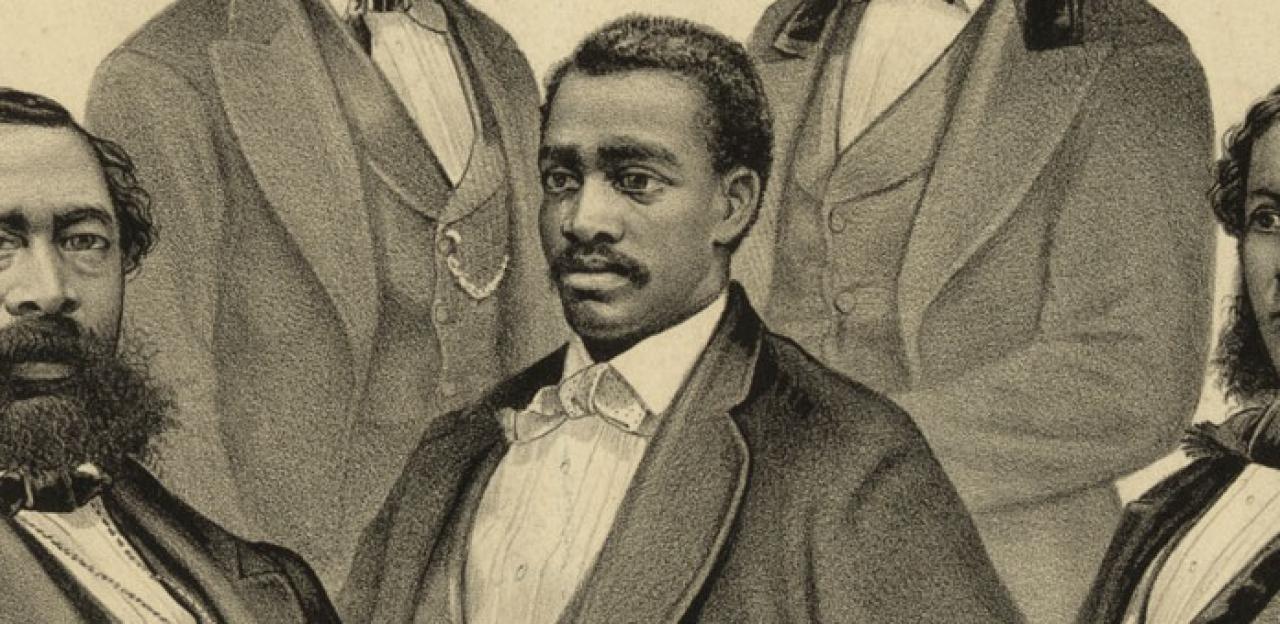
Grades: High School
Approximate Length of Time: 3 hours excluding the final essay
Goal: Students will be able to discuss and cite the outcomes of the reconstruction period – 1863-1877.
Objectives:
- Students will be able to complete questions, finding key information within primary and secondary sources.
- Students will be able to address a question about a historic event, providing evidence from primary and secondary sources.
- Students will be able to identify ways in which historic events impact current events.
Common Core Standards:
CCSS.ELA-LITERACY.RH.6-8.1 Cite specific textual evidence to support analysis of primary and secondary sources.
CCSS.ELA-LITERACY.RH.6-8.2 Determine the central ideas or information of a primary or secondary source; provide an accurate summary of the source distinct from prior knowledge or opinions.
CCSS.ELA-LITERACY.RH.6-8.4 Determine the meaning of words and phrases as they are used in a text, including vocabulary specific to domains related to history/social studies.
CCSS.ELA-LITERACY.WHST.6-8.1 Write arguments focused on discipline-specific content.
CCSS.ELA-LITERACY.WHST.6-8.2 Write informative/explanatory texts, including the narration of historical events, scientific procedures/ experiments, or technical processes.
NCSS Standards for Social Studies:
1—Culture 2—Time, Continuity, and Change 3—People, Places, and Environment 5—Individuals, Groups, and Institutions 6—Power, Authority, and Governance 10—Civic Ideals and Practices
Description:
This is an inquiry lesson where students will do research to answer the inquiry question concerning the reconstruction period following the civil war. Students will develop a hypothesis, search for evidence in multiple primary and secondary sources, and complete a graphic organizer. Through this process students will develop a strong answer to the inquiry question posed at the beginning.
Inquiry Question:
What are the outcomes of the period known as Reconstruction?
- Primary Source Documents Packet
- Some of the secondary sources are links, be sure to allow access to the internet for these documents and videos
- Final Essay
- Highlighters
- The PowerPoint will act as a guide for the lesson. The PowerPoint is so detailed, it can even be done independently by students.
- There are videos within the PowerPoint that should be queued-up ahead of the lesson presentation.
- Documents within the Primary Source packet and Secondary Source packet will be referred to through-out the PowerPoint. Some of the documents are required reading, while others are noted in the PowerPoint as ‘provided,’ meaning the document has been provided but is not required reading. The provided documents might be useful for more in-depth understanding or for research purposes. Students may wish to look over and cite these documents for their essay.
- For each document guiding questions are provided, it is up to the teacher as to whether or not these need to be answered. The questions help focus students’ attention and guide in the formation of their own document related questions.
- Students should provide citations to documents as they complete the storyboard, this will act as an organizer/outline for their final essay.
Conclusion:
Students will answer the inquiry question either orally or in essay form (Essay is provided). They should use evidence from their primary and secondary sources. They can use the documents, their notes, the storyboard, and their answered questions. Students can do additional research to bolster their argument.
Assessment in this Lesson:
- Completed storyboard.
- A complete answer to the inquiry question with citations from the provided documents.
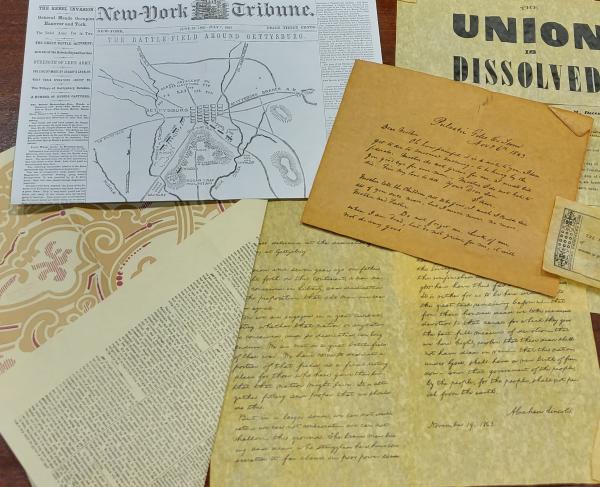

6 Primary Sources from the American Civil War
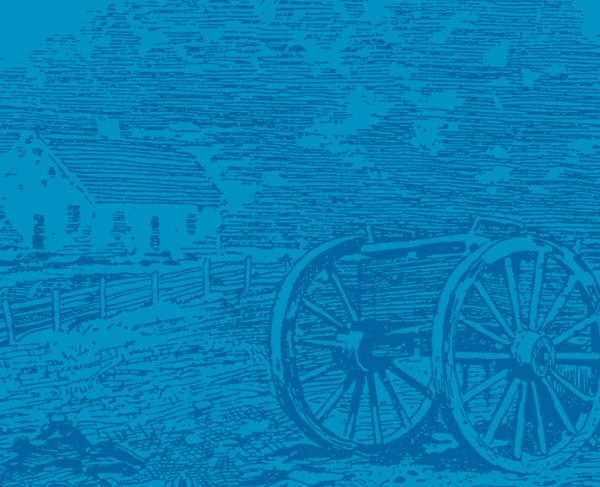
Antietam 360: Natural and Man-made Features Middle School Lesson Plan
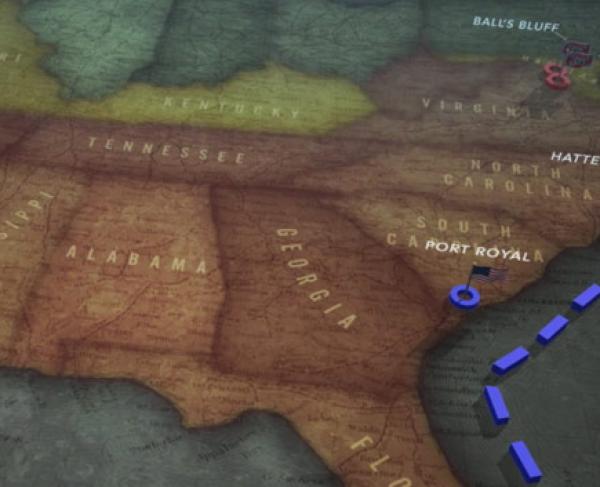
The Civil War Animated Map: Traditional Middle School Lesson Plan
Civil War & Reconstruction
Lesson plan.

The Civil War and Reconstruction Era brought about the end of slavery and the expansion of civil rights to African Americans through the 13th, 14th, and 15th Amendments. Compare the Northern and Southern states, discover the concepts of due process and equal protection, and understand how the former Confederate states reacted to the Reconstruction Amendments.
Pedagogy Tags

Teacher Resources
Get access to lesson plans, teacher guides, student handouts, and other teaching materials.

- Civil War and Reconstruction_Lesson Plan.pdf
- Civil War and Reconstruction_StudentDocs.pdf
I find the materials so engaging, relevant, and easy to understand – I now use iCivics as a central resource, and use the textbook as a supplemental tool. The games are invaluable for applying the concepts we learn in class. My seniors LOVE iCivics.
Lynna Landry , AP US History & Government / Economics Teacher and Department Chair, California
Related Resources
A movement in the right direction (infographic).
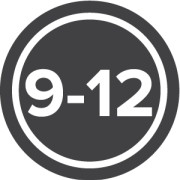
Breaking Barriers: Constance Baker Motley
Civic action and change.

Civil Rights Act of 1964

Historical Monuments & Meaning

Little Rock: Executive Order 10730
Resisting slavery, slave states, free states, slavery: no freedom, no rights.

See how it all fits together!

Civil War and Reconstruction Toolkit
The American Civil War was fought from 1861-1865, and followed by the period of Reconstruction, generally accepted by scholars to have ended in 1877. The following collections include documents essential to gaining and understanding of how the war began, progressed, and ended, and how Reconstruction was conceived and attempted.
Guiding Questions
- What did Americans think about slavery and emancipation as a constitutional matter, and how did their disagreement over the institution and its possible elimination shape the coming of the Civil War and its prosecution?
- How did Americans understand secession and the problem it posed for the viability of self-government?
- How did Lincoln and Americans understand the nature of the federal union and Constitution in relation to state sovereignty?
- What problems did Reconstruction pose for Presidents and Congresses both during and after the Civil War, and to what extent did the federal structure of the American union, along with the 13 th , 14 th , and 15 th Amendments, complicate the return of peaceful self-government to the United States?
Suggested answers
Essential Documents
- Fragment on the Constitution and Union , 1861, Abraham Lincoln
- South Carolina Declaration of Causes of Secession , 1860
- “Corner Stone” Speech , 1861, Alexander Stephens
- The War – Its Cause and Cure , 1861, William Lloyd Garrison
- Message to Congress in Special Session , 1861, Abraham Lincoln
- Letter to Horace Greeley , 1861, Abraham Lincoln
- Final Emancipation Proclamation , 1863, Abraham Lincoln
- Gettysburg Address , 1863, Abraham Lincoln
- Resolution Submitting the Thirteenth Amendment to the States , 1865, Abraham Lincoln
- Oration in Memory of Abraham Lincoln , 1876, Frederick Douglass
- Documents in Detail: Gettysburg Address
- Moments of Crisis: The Assassination of Abraham Lincoln
- Documents in Detail: Lincoln’s Second Inaugural Address
- American Controversies: Did Lincoln Violate the Constitution?
- Great American Debates: Secessionists vs. Unionists
- American Minds: Frederick Douglass
- Documents in Detail: Lincoln’s Fragment on the Constitution and Union
- Special Webinar: What Can We Learn from the Election of 1860?
- Special Webinar: Heroes of the Civil War
- Enduring American Questions: Did Slavery Cause the Civil War?
- Documents in Detail: “Cornerstone” Speech
- Documents in Detail: Final Emancipation Proclamation
Lesson Plans
- On the Eve of War – A one-day lesson focused on the relative strengths and weaknesses of the North and the South on the eve of the American Civil War
- Battles of the Civil War – Help students learn the essentials about important battles of the war in this two-day lesson
- Abraham Lincoln and Wartime Politics – This in-depth 3-4 day lesson explores Lincoln’s handling of the war as a political event
- Abraham Lincoln on the American Union – a four-lesson arc examining the president, his ideas, and his actions
- The Battle over Reconstruction – a three-lesson mini-unit on the tumultuous years after the war
- Making Sense of Secession – a week-long sequence of lessons exploring Southern justifications – constitutional, legal, and moral – for secession
- Civil Rights, Andrew Johnson, and the Radical Republicans – a 3-day lesson sequence helping students understand the foundation of the post-Civil War Civil Rights movements
Receive resources and noteworthy updates.

Lesson Plans
- Primary Documents
- Video Transcripts
- Instructions
- The Backstory

Lesson overview: Freedpeople built and expanded existing institutions during Reconstruction, many of which had their roots in practices begun by enslaved people. They included religion, education, benevolent organizations, the press, and the family. Today’s lesson titled, “Teaching Ourselves,” focuses on education. The power of education was incalculable. Even before the Civil War, the South had the highest rate of illiteracy for both Black and white populations. Although benevolent organizations such as Northern missionary societies, the Freedmen’s Bureau, and other supporters raised money to support teachers and build schools for freedpeople, it was the formerly enslaved who worked the hardest to educate themselves. The Reconstruction governments elected after the enfranchisement of Black men founded more than 3,000 schools. Freedpeople, even the poorest, held fundraisers to pay teachers, and donated land and labor to build schools.
Essential Question: How did freedpeople use institutions to create social change during Reconstruction?
Driving Questions: Why did freedpeople consider education an integral institution during Reconstruction?
Lesson Progression
- The teacher will introduce Reconstruction 360 and determine prior knowledge about the Reconstruction period through classroom discussion. If the class has completed the module “A Seat at the Table,” prior knowledge could include five things students learned from completing that lesson.
- The teacher will direct students in watching the immersive 360 video/module, “Teaching Ourselves.”
After showing the module, the teacher will give students a prompt and lead students in a discussion:
Prompt: Places have personalities. The personality of a place often reflects its purpose and those who inhabit it. Before doing any research, it is helpful to record first impressions. In watching the “Teaching Ourselves” scene, what can you learn about the place where the scene was shot and the people in the scene?
What are your initial observations about the place and the people shown in the video “Teaching Ourselves” ?
Portrait of Lincoln
Group of Children
Spelling Book
- Neighbor – Older Woman
- Teacher – Younger Woman
- Church Pew – Church as School
- Stack of Books – Freedmen’s Bureau
- Pulpit – Missionary Societies
Chalkboards
Map of the World
- Groups should use their device/devices to rewatch the video and explore the various immersive aspects of the 360 technology, especially focusing on the embedded videos. The teacher should encourage groups to explore all the videos, not just the one assigned to their group.
- After groups have had time to explore the features of “Teaching Ourselves,” the teacher will give each group a central question that requires groups to define the primary aspects of their hot spot. Each group must write one group-agreed-upon response to their question.
- The teacher will place a masking tape line on the wall of the classroom. The line will represent the spectrum of responses that groups and individuals may have. One end of the line will indicate a “100%/Absolute Yes” response. The other end of the tape will represent a “0%/Absolute No” response with tags for 75%, 50%, and 25% as well.
- The teacher will ask each group to Walk the Line , one group at a time. The groups will choose a percentage of certainty they feel about their response.
- Using a worksheet, each group will record their percentage choice along the spectrum, as well as their written justification of their choice. The group will in turn place themselves on the tape beside the percentage they have chosen.
- The group will read their response to the teacher prompt to the entire class.
- Students in other groups will make a judgement based on their personal interpretation of the prompt, which was read by the presenting group. Individual students will place themselves along the continuum wall line, choosing a percentage that represents their view of the prompt.
- The teacher should advise individual students that they may be questioned about their choice of percentage. Students should be prepared to justify their choice if questioned.
- This process will continue until all 10 groups have presented. When all the presentations are completed, the continuum wall line should have markers indicating the percentage chosen by each group as well as their written responses which are taped under the percentage they chose.
Hot Spot Prompts
Think about time and how perception changes as time passes. Given the time between Lincoln’s assassination and the opening of schools for children of former slaves, how would your group respond to the following prompt?
Teacher prompt: Former slaves were justified in idolizing Lincoln and giving him the title of the Great Emancipator.
Our group feels the response to the prompt falls at this percentage along the spectrum:
We feel that it falls at this percentage because:
Think about the period following emancipation. What opportunities were available to families that were new to their lives as emancipated people? How would your group respond to the following prompt?
Teacher prompt: Education seemed to distract from the responsibilities of living and surviving as newly freed people.
Communication has many components. Slavery purposely limited how those enslaved were allowed to communicate. Thinking of communication and its many components, how would your group respond to the following prompt?
Teacher prompt: Noah Webster’s Elementary Spelling Book impacted the way freedmen interacted and communicated with those in and out of their communities.
Older Woman – Community Member
Schools are part of our community. Communities form the foundation of larger societies. Think about how difficult it was for children of freedpeople to become educated citizens. How would your group respond to the following prompt?
Teacher prompt: Education for children of freedpeople was difficult because support from communities and society was sparse.
Younger Woman – Teacher
Often historians evaluate periods of time based on the words and actions of past leaders of a particular period. Reconstruction is marked by leaders and groups trying to provide opportunities where they once did not exist. How would your group respond to the following prompt?
Teacher prompt: Normal schools were a jewel in the crown of Reconstruction, providing educational opportunities for freedmen throughout the South.
Church as School – Pew
Freedpeople left slavery with very few possessions and what little they could carry. Think about what institutions define a society. If your family, and those you know, were in a similar situation, what institutions would you be sure to include in your new community? What issues are you going to have to confront? How would your group respond to the following prompt:
Teacher prompt: Communities created by freedmen often relied on the generosity of white land owners to establish needed institutions.
Freedmen’s Bureau – Stack of Books
Think about radical change and how people react when old established traditions are no longer practiced. In what ways would an organization like the Freedmen’s Bureau be helpful to people who are trying to establish themselves in society? How would your group respond to the following prompt?
Teacher prompt: The Freedmen’s Bureau was an offshoot of the US military and was not helpful in promoting education in African American communities.
Missionary Societies – Pulpit
A benevolent act is defined as charitable act that is intended to benefit rather than profit. Think about the different charitable organizations today that help people throughout the world and during times of need. Many of these organizations have been started and funded by churches and their congregations. Looking at how the private sector can and does help the public sector of society, how would your group respond to the following prompt?
Teacher prompt: Many private benevolent societies from the North came to the South to help freedpeople learn skills needed to function in a free society.
Educational aids have existed for well over 5,000 years. In this activity you are using tablets and/or computers to watch videos and explore hotspots found in the Teaching Ourselves video. How would your group respond to the following prompt?
Teacher prompt: Educational aids help students learn.
Slavery closed educational and geographic boundaries. Think about individuals who escaped slavery and were able to travel. Imagine how their view of the world changed when they traveled to places where slavery was abolished. How would your group respond to the following prompt?
Teacher prompt: Travel can change perspectives and give knowledge to the traveler and those he/she impacts.
Group Assessment Activity
As a final assessment of what students have learned from Teaching Ourselves , and to answer the Driving question, groups will be asked to continue the “Slide Book” begun with the module A Seat at the Table . If that lesson was not completed, students must create a new “Slide Book”. If this is a continuation of the first “Slide Book” students will be adding a chapter 4 titled My Driving Question Explained in a Six-Word Novel .
- A Six-Word Novel succinctly explains the gist of a topic or question. Groups must brain-storm and come up with six words they believe encapsulates a response to the driving question, Why did freedpeople consider education an integral institution during Reconstruction?
- An example of a Six-Word Novel can be found in Ernest Hemingway’s challenge to write a novel using only six words. His response was as follows: “For sale: baby shoes, never worn.”
- Six-Word Novels may generate further questions or discussion. There is an additional activity in the Lesson Extension section below that will allow students to explore this aspect of Six-Word Novels.
- There should be one master Slide Book for the class. Each group will add their Six-Word Novel to a page under the chapter titled My Driving Question Explained in a Six-Word Novel .
Lesson Extensions
- If time permits, a logical extension of the lesson would be to allow different groups to ask questions that the Six-Word Novel did not address. For example, in Hemingway’s novel one might want to know why the baby shoes were never worn. The teacher can determine a maximum or minimum number of questions each group can generate and specifically whose novel they are to ask questions about.
- Refer to the video found by clicking on the flowers given to the teacher. As an additional activity students can research the types of wildflowers found in their local area by taking pictures of wildflowers in their neighborhood and identifying them using an application or different resources. We have listed some resources below. Students can create a simple “plant identification slide show” showing the plant, where it commonly resides, and the season it blooms. Plants must be native to the area. They can be domestic plants or weeds.
- Students can create a biodome that contains common weeds that are found in their area. They should include a written explanation of the plants and how these plants enhance and contribute to local natural habitats.
- Students will refer to the Reconstruction map link found in the resources. The link shows the Confederate states that were occupied during the Reconstruction period. Students can choose a particular state or a Reconstruction military district and must research historically black colleges/universities (HBCUs) that currently still exist but were initially established during the Reconstruction period. Using Google Maps, students will drop pins showing the location of current colleges and/or universities and write a brief description of the school and its history.
Teacher Notes
- Teachers should explore the Reconstruction 360 module “Teaching Ourselves” prior to showing the module in class. On the toolbar of the module there is an “Explore” pull down menu. This menu contains links to all the embedded videos within the module. They can be accessed through this explore option or by scrolling over and clicking the people/topics as the module is shown.
- The teacher can decide whether to allow extra credit using the lesson extension. The top three questions for each Six-Word Novel could be added as an additional page to the class “Reconstruction 360 Slide Book” and could provide additional opportunities for lesson extensions and/or extra credit by having students research the questions they added to the lesson.
- The Teacher Prompts connected to the Walk the Line activity are purposely written to elicit either positive or negative responses. The idea behind this is to force students to really examine their “hot spot” and decide if the prompt is accurate based on the information found in the prompt and on prior knowledge they have learned from other activities completed in the Reconstruction 360 series.
- The teacher can decide where the Reconstruction Slide Books should be published. There are many options including Google Classroom, Nearpod, and Edmodo. A link that allows teachers to view various options has been included in the resources.
- Please note, included in the resources is a link that will provide a listing of all Historically Black Colleges and Universities found in the former Confederate states. Some listed were established after Reconstruction. If completing the lesson extension on maps, students should be aware to only include those colleges/universities that were established in the South during the Reconstruction period.
Six-Word Novel Rubric
Ideas/Content: Your novel is deep and powerful; instead of just being a basic description of your topic. It is centered around a primary idea that explains the relevance of a person or group and their purpose and/or role during Reconstruction.
Word Choice: You have chosen powerful, vivid, specific verbs and nouns.
Voice: Your novel accurately depicts your person or group’s place in history. Your Six-Word Novel succinctly provides a response to the driving question, Why was education considered an integral institution for freedpeople during Reconstruction?
Connections: Your novel gives accurate information to the reader yet, fosters a desire to learn more about the topic. The reader may have questions that may lead to further investigation.
Lesson Extension Resources
https://backgarden.org/plant-identification-apps/
https://nativebackyards.com/inaturalist-app-to-identify-plants/
http://www.scwf.org/native-plant-list/
Explanation of how to drop a pin on Google Maps – https://www.freecodecamp.org/news/dropped-pins-in-google-maps-how-to-pin-a-location-and-remove-a-pin/
Reconstruction Map link - https://yhoo.it/3p9uUaW
List of historically black colleges and universities - https://en.wikipedia.org/wiki/List_of_historically_black_colleges_and_universities
Slide Book Publishing Options
https://elearningindustry.com/the-5-best-free-tools-for-publishing-student-work
https://nearpod.com/
https://new.edmodo.com/
SC Standards
Grade 4: Standard 5 – Indicators 4.5.CO, 4.5.P, 4.5.CX
Grade 8: Standard 4 – Indicator 8.4.CO
US History and the Constitution: Standard 2 – Indicators USHC.2.CC, USHC.2.E
MA in American History : Apply now and enroll in graduate courses with top historians this summer!
- AP US History Study Guide
- History U: Courses for High School Students
- History School: Summer Enrichment
- Lesson Plans
- Classroom Resources
- Spotlights on Primary Sources
- Professional Development (Academic Year)
- Professional Development (Summer)
- Book Breaks
- Inside the Vault
- Self-Paced Courses
- Browse All Resources
- Search by Issue
- Search by Essay
- Become a Member (Free)
- Monthly Offer (Free for Members)
- Program Information
- Scholarships and Financial Aid
- Applying and Enrolling
- Eligibility (In-Person)
- EduHam Online
- Hamilton Cast Read Alongs
- Official Website
- Press Coverage
- Veterans Legacy Program
- The Declaration at 250
- Black Lives in the Founding Era
- Celebrating American Historical Holidays
- Browse All Programs
- Donate Items to the Collection
- Search Our Catalog
- Research Guides
- Rights and Reproductions
- See Our Documents on Display
- Bring an Exhibition to Your Organization
- Interactive Exhibitions Online
- About the Transcription Program
- Civil War Letters
- Founding Era Newspapers
- College Fellowships in American History
- Scholarly Fellowship Program
- Richard Gilder History Prize
- David McCullough Essay Prize
- Affiliate School Scholarships
- Nominate a Teacher
- Eligibility
- State Winners
- National Winners
- Gilder Lehrman Lincoln Prize
- Gilder Lehrman Military History Prize
- George Washington Prize
- Frederick Douglass Book Prize
- Our Mission and History
- Annual Report
- Contact Information
- Student Advisory Council
- Teacher Advisory Council
- Board of Trustees
- Remembering Richard Gilder
- President's Council
- Scholarly Advisory Board
- Internships
- Our Partners
- Press Releases
History Resources

Lincoln’s Reconstruction Plan
By rosanne lichatin, essential question.
To what degree was Abraham Lincoln successful in achieving his goals?
The Civil War was perhaps the most momentous event that the United States endured in its history. Author and historian Shelby Foote said, "Any understanding of this nation has to be based on an understanding of the Civil War. . . . It was the crossroads of our being." The key personality in that contest was President Abraham Lincoln, who had the arduous task of steering this nation through the war and also the more difficult challenge of determining a course for peace and Reconstruction. As war leader and peacemaker, he faced criticism from political opponents as well as from members of his own party. This lesson will allow students to explore Lincoln’s words, speeches, and proclamations in order to understand his views on secession, amnesty, and Reconstruction, as well as his hopes for the nation.
- Students will examine primary documents in order to understand and evaluate Lincoln’s plans for Reconstruction.
- Students will be able to identify the specific proposals Lincoln made for the readmission of Southern states, amnesty, and opportunities for freedmen.
- Students will analyze the conflict between the executive and legislative branches in trying to assert control over Reconstruction during Lincoln’s term.
- Students will recognize the need for cooperation and compromise in creating federal policy on Reconstruction.
- Students will recognize the significance of Lincoln’s Second Inaugural Address in setting the tone of reconciliation for the nation.
- Lincoln’s Proclamation of Amnesty and Reconstruction , University of Maryland
- Wade-Davis Bill , Our Documents
- Lincoln’s Second Inaugural Address , Yale University, Avalon Project

Homework Assignment #1
Divide the class in half. One half will be assigned Lincoln’s Proclamation of Amnesty and Reconstruction. The other half will read the Wade-Davis Bill.
Students should answer the following questions in writing and be prepared to discuss them in class the next day:
- Who is the author of this document and when was it produced?
- According to the document, who should control Reconstruction?
- According to the document, what is the role of the executive branch? The legislative branch?
- What conditions must be met for Southern states to be readmitted to the Union?
- Who should be excluded from readmission? Is a rationale provided to justify this exclusion? Do you support it?
- Does this document indicate any provisions to support or assist former slaves?
- Who do you think would support this document? Who would reject it?
- What do you believe is the strength of this proposal?
- What difficulties do you believe might arise if this proposal was accepted?
- Choose one adjective to describe the terms of this plan. Be prepared to defend your choice.
All students will read the Wade-Davis Bill in class and comment on Lincoln’s response.
- What argument does Lincoln provide for not accepting the Wade-Davis Bill?
- If you had been a member of Congress who had supported the Wade-Davis Bill, how would you have reacted to Lincoln’s pocket veto?
Homework Assignment #2
Students should read Lincoln’s address for homework and come to class prepared to discuss its importance. The class will be divided into groups of three to discuss and respond to the following questions:
- To whom do you think Lincoln was addressing his comments?
- In her book Team of Rivals , Doris Kearns Goodwin says about Lincoln, "More than any of his other speeches, the Second Inaugural fused spiritual faith with politics." Identify specific comments made by Lincoln that prove this statement.
The class will be divided into groups of three to discuss and respond to the homework question.
Suggested Enrichment
The following documents can be shared with students to bring the inauguration and the activities surrounding it to life:
- Read George Rable’s essay, " Lincoln’s Civil Religion ," in the Lincoln issue of History Now (Winter 2005).
- An additional resources for an analysis of Lincoln’s Second Inaugural Address: "President Lincoln's Second Inaugural Address, 1865," a Spotlight on a Primary Source by Abraham Lincoln
- " An Inaugural Poem " dedicated to Abraham Lincoln of Illinois and Andrew Johnson of Tennessee from the Library of Congress. Printed in the Inauguration Procession of Lincoln and Johnson, Chronicle Junior Each stanza will be assigned to two students to analyze. Students will read the entire poem and then be responsible for reporting the meaning of their stanzas to the rest of the class. As part of that exercise, they will discuss how the poem frames the challenge Lincoln faced in saving the Union.
- Students will read the following in class: Chandra Manning, "Douglass, Lincoln, and the Civil War," History Now 50: "Frederick Douglass at 200," Winter 2018 James Oaked, "Douglass and Lincoln: A Convergence," The Gilder Lehrman Institute
- The teacher will lead a discussion that focuses on the following questions:
- In what way did Lincoln make Douglass feel that he was supportive of African Americans?
- What words from the inaugural address do you think impressed Frederick Douglass the most?
Application
- Write a letter to the editor of a newspaper either supporting or opposing: Andrew Johnson’s plan for Reconstruction OR the Radical Reconstruction plan.
- Write a newspaper editorial responding to Lincoln’s Second Inaugural Address.
- Create an annotated historical timeline of Lincoln’s Reconstruction policies.
Stay up to date, and subscribe to our quarterly newsletter.
Learn how the Institute impacts history education through our work guiding teachers, energizing students, and supporting research.
- New Lessons
- Popular Lessons
- Explore by Time Period
- Explore by Theme
- Explore by Resource Type
- This Day In People’s History
- If We Knew Our History Series
- New from Rethinking Schools
- Workshops and Conferences
- Teach Reconstruction
- Teach Climate Justice
- Teaching for Black Lives
- Teach Truth
- Teaching Rosa Parks
- Abolish Columbus Day
- Project Highlights
Teach Reconstruction Campaign
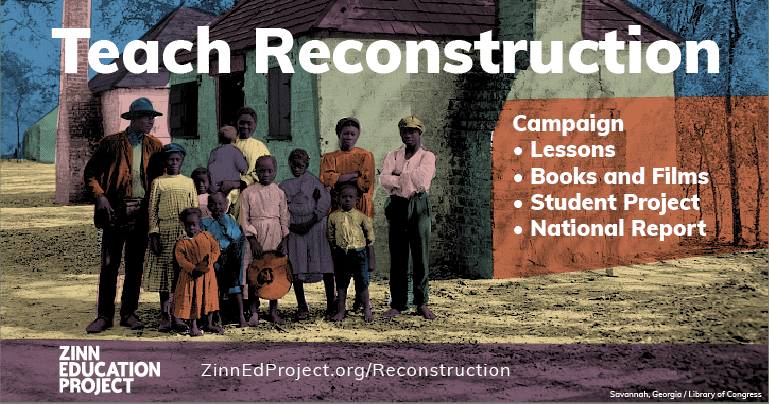
Reconstruction, the era immediately following the Civil War and emancipation, is full of stories that help us see the possibility of a future defined by racial equity. Yet the possibilities and achievements of this era are too often overshadowed by the violent white supremacist backlash. Too often the story of this grand experiment in interracial democracy is skipped or rushed through in classrooms across the country. Today — in a moment where activists are struggling to make Black lives matter — every student should probe the relevance of Reconstruction. Our campaign aims to help teachers and schools uncover the hidden, bottom-up history of this era.
We offer lessons for middle and high school, a national report, a student campaign to make Reconstruction history visible in their communities, and an annotated list of recommended teaching guides, student friendly books, primary document collections, and films. This campaign is informed by teachers who have used our Reconstruction lessons and a team of Reconstruction scholars.
Sections: Why • Lessons • National Report • Textbook Critique • Petition • Share Your Story • Related Resources • Student Project • Open Letter • Support • Advisors • In the News
When Black Lives Mattered: Why Teach Reconstruction
Reconstruction, the era immediately following the Civil War and emancipation, is full of stories that help us see the possibility of a future defined by racial equity. Though often overlooked in classrooms across the country, Reconstruction was a period where the impossible suddenly became possible.
Back to top
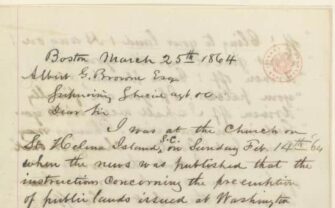
Reconstructing the South: What Really Happened
A follow-up lesson to “Reconstructing the South,” using primary source documents to reveal key outcomes of the Reconstruction era.
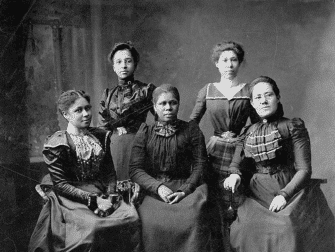
Teaching the Reconstruction Revolution: Picturing and Celebrating the First Era of Black Power
A lesson that help students understand, imagine, and celebrate the Reconstruction period as the first era of Black power in the United States.
Reconstructing the South: A Role Play
This role play engages students in thinking about what freedpeople needed in order to achieve — and sustain — real freedom following the Civil War. It’s followed by a chapter from the book Freedom’s Unfinished Revolution on what would happen to the land in the South after slavery ended.
Teacher Comments “I found the lesson plan to be a valuable addition to my teaching about this era. The students were engaged in their roles and, later, more engaged than ever before in finding out what choices were actually made the years following the Civil War .” — Amy Grant, a middle school social studies teacher, Dexter, Michigan
▸ Read more teacher comments .
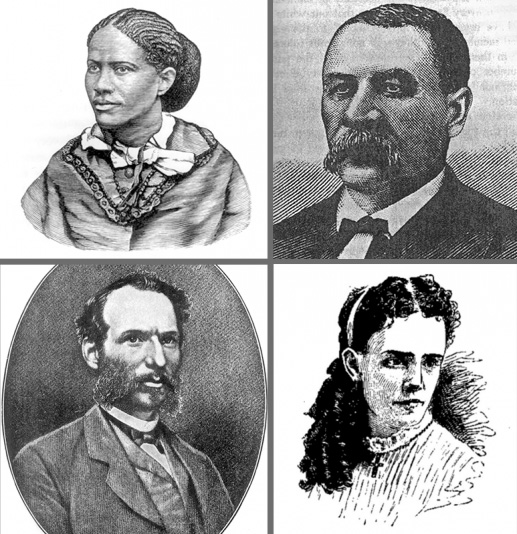
Clockwise: Frances Harper, Isaac Myers, William Sylvis, and John Roy Lynch are a few of the people featured in the role play.
When the Impossible Suddenly Became Possible: A Reconstruction Mixer
A mixer role play that explores the connections between different social movements during Reconstruction, introducing students to individuals in the labor movement, women’s rights, and voting rights movements that followed the Civil War and their attempts to build alliances with one another.
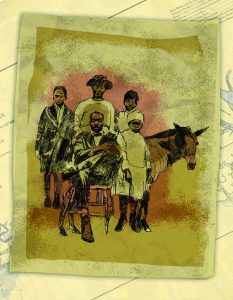
Keith Henry Brown
40 Acres and a Mule: Role-Playing What Reconstruction Could Have Been
This multimedia, creative role play introduces students to the ways African American life changed immediately after the Civil War by focusing on the Sea Islands before and during Reconstruction.
Many historians term this post-war experiment in grassroots democracy and Black self-determination that occurred in the coastal Sea Islands a “rehearsal” for Reconstruction. But the Sea Islands experiment was more than a rehearsal; subsequent Reconstruction plans lacked the key ingredient that made it revolutionary: the redistribution of land.
Who Killed Reconstruction? A Trial Role Play
A role play about the demise of Reconstruction that helps students get beyond the question “Was Reconstruction a success or failure?”
This trial role play encourages students to take a broader view of Reconstruction’s demise looking at the role of the major political parties and their wealthy backers, the racism of poor white people, and the systems of white supremacy and capitalism.
More lessons : The Reconstruction Era and the Fragility of Democracy from Facing History and Almost Emancipated: Reconstruction from Teach Rock.

The Zinn Education Project produced a national report, “ Erasing the Black Freedom Struggle: How State Standards Fail to Teach the Truth About Reconstruction, ” on the teaching of the Reconstruction era, including a state-by-state assessment.
The report, released in January of 2022, examines state standards, course requirements, frameworks, and support for teachers in each state. It also includes stories about creative efforts by districts and/or individual teachers in each state to teach outside the textbook about Reconstruction.

One cannot study Reconstruction without first frankly facing the facts of universal lying,” explained scholar W. E. B. Du Bois in 1935. Spurred by that directive, we offer Five Ways Textbooks Lie About Reconstruction by Mimi Eisen as an addition to our national report, Erasing the Black Freedom Struggle .
Sign the petition urging school boards to examine how much time is dedicated to teaching the Reconstruction era in kindergarten through 12th grade, make a plan to increase it, and ensure that teaching materials and curricula in schools reflect the everyday people who powered these movements.

Stories from the classroom can inform and inspire more teachers to use lessons on reconstruction. We invite you to share your story . Selected responses will be posted at the Zinn Education Project website .

The “ Make Reconstruction History Visible ” mapping project is an opportunity for students and teachers to identify and advocate for recognition of Reconstruction history in their community. This helps students learn about this vital era in U.S. history while also playing an active role in giving visibility to an era that has been hidden or misrepresented for too long.
For this project, students (individually or as a class) identify and document Reconstruction history such as schools, hospitals, election sites, Freedmen’s Bureau offices, Black churches, Black newspapers, Black owned businesses, prominent individuals, organizations, key events, and more. Learn how to participate .
The Other ’68: Black Power During Reconstruction
Article By Adam Sanchez
From the urban rebellions to the salute at the Olympics, commemorations of 1968 — a pivotal year of Black Power — have appeared in news headlines throughout this anniversary year. Yet 2018 also marks the 150th anniversary of 1868 — the height of Black Power during Reconstruction. Read more .
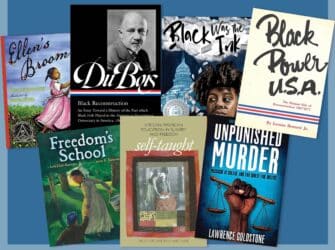
Related Resources
Readings, primary documents, and films for classrooms about the Reconstruction era .

The Teach Reconstruction campaign is made possible by donations from individuals. Please contribute today so that more teachers receive free lessons on Reconstruction history and more students can participate in the Make Reconstruction History Visible project. Donate now!
- Shawn Leigh Alexander is a professor and the chairperson of African and African American Studies and the director of the Langston Hughes Center at the University of Kansas. Alexander is the author of An Army of Lions: The Civil Rights Struggle Before the NAACP , and editor of Reconstruction Violence and the Ku Klux Klan Hearings .
- Derek W. Black is a professor of law and the Ernest F. Hollings Chair in Constitutional Law at the University of South Carolina. He is the author of Schoolhouse Burning: Public Education and the Assault on American Democracy .
- David Blight is a professor of history at Yale University and the director of the Gilder Lehrman Center for the Study of Slavery, Resistance, and Abolition at Yale. Blight is the author of Frederick Douglass: Prophet of Freedom , A Slave No More: Two Men Who Escaped to Freedom , and Race and Reunion: The Civil War in American Memory .
- Greg E. Carr is an associate professor of Africana Studies, the chair of the Department of Afro-American Studies at Howard University, and an adjunct professor at the Howard School of Law. Carr is a co-founder of the Philadelphia Freedom Schools Movement.
- Michael Charney is a retired public school social studies teacher with over 30 years of experience in education, labor organizing, and education policy. He provides strategic guidance and support for the Teach Reconstruction campaign. Charney wrote curriculum guides to support student organizing including “Fulfilling the Promise of America: The Struggle for Voting Rights,” “ The Minimum Wage and the Youth Vote (PDF),” and the “Present as History: A Look into the Origins of the Cleveland School Desegregation Case.”
- Gregory P. Downs is a professor of history at the University of California, Davis, and the author of After Appomattox: Military Occupation and the Ends of War . Downs is also a co-author of the National Parks Service’s theme study, The Era of Reconstruction, 1861–1900 .
- Jim Downs is the Gilder Lehrman NEH Professor of Civil War Era Studies at Gettysburg College. Downs is the author of several books including Sick from Freedom: African-American Illness and Suffering during the Civil War and Reconstruction and Beyond Freedom: Disrupting the History of Emancipation , which he co-edited with David Blight.
- Hilary N. Green is a professor of history, Africana Studies Department, at Davidson College. Green is the author of Educational Reconstruction: African American Schools in the Urban South, 1865–1890 .
- Steven Hahn is a professor of history at New York University and the author of A Nation Under Our Feet: Black Political Struggles in the Rural South from Slavery to the Great Migration .
- William Loren Katz was the author of numerous books on U.S. history for middle school students, including An Album of Reconstruction. ( In Memoriam .)
- Chenjerai Kumanyika is a researcher, journalist, artist, and assistant professor in Rutgers University’s Department of Journalism and Media Studies. He is also the co-executive producer and co-host of Uncivil , Gimlet Media’s podcast on the Civil War.
- James Loewen was a professor of sociology at the University of Vermont and the author of several books including Lies My Teacher Told Me , Lies Across America: What Our Historic Sites Get Wrong , and The Confederate and Neo-Confederate Reader: The “Great Truth” about the “Lost Cause” . ( In Memoriam .)
- Kate Masur is a professor of history at Northwestern University and the author of Until Justice Be Done: America’s First Civil Rights Movement, From the Revolution to Reconstruction and An Example for All the Land: Emancipation and the Struggle Over Equality in Washington, D.C. Masur is also the co-author of the National Parks Service’s theme study, The Era of Reconstruction, 1861–1900 .
- Jeremy Nesoff is the associate program director for Facing History’s Leadership Academy. Among his roles is leading work connected to the curriculum unit The Reconstruction Era and The Fragility of Democracy .
- Paul Ortiz is the director of the Samuel Proctor Oral History Program at the University of Florida. Ortiz is the author of Emancipation Betrayed: The Hidden History of Black Organizing & White Violence in Florida from Reconstruction to the Bloody Election of 1920 and An African American and Latinx History of the United States .
- Tyler Parry is an assistant professor of African American and African Diaspora Studies at the University of Nevada, Las Vegas. He is the author of “ Black Radicalism and the ‘Tuition-Free’ University ,” an article exploring the profound impact South Carolina’s majority Black Reconstruction era legislature had on public education.
- Tiffany Mitchell Patterson is a manager of social studies at District of Columbia Public Schools (DCPS). Prior to joining the central services social studies team at DCPS, she served as an assistant professor of secondary social studies at West Virginia University. She taught middle school social studies for 10 years in Washington, D.C., and Arlington, Virginia.
- David Roediger is the foundation distinguished professor at the University of Kansas. He is the author of several books on race and class in the U.S. including Seizing Freedom: Slave Emancipation and Liberty for All .
- Mark Roudané is a retired early childhood teacher. He curates the digital archive of his great, great grandfather, Charles Roudanez , who founded the New Orleans Daily Tribune , the first daily Black newspaper during Reconstruction.
- Manisha Sinha is the James L. and Shirley A. Draper Chair in American History at the University of Connecticut. She is the author of The Counterrevolution of Slavery: Politics and Ideology in Antebellum South Carolina and The Slave’s Cause: A History of Abolition .
- Stephen West is an associate professor of history at the Catholic University of America. West is author of From Yeoman to Redneck in the South Carolina Upcountry, 1850–1915 and co-editor of Freedom: A Documentary History of Emancipation, 1861–1867, series 3, volume 2, Land and Labor, 1866–1867 .
- Kidada E. Williams is an associate professor of history at Wayne State University. Williams is the author of They Left Great Marks on Me: African American Testimonies of Racial Violence from Emancipation to World War I and the producer and host of Seizing Freedom , VPM’s podcast on Black people’s quest for liberation, progress, and joy in the United States.
Educator Survey
Our national report will be continuously updated. Teachers and other staff at the state, district, or classroom level are invited to complete one of the short surveys below. Respondents receive a subscription to Rethinking Schools magazine in appreciation for their time.
- Click to email a link to a friend (Opens in new window)
- Click to share on Pinterest (Opens in new window)
- Click to share on Twitter (Opens in new window)
- Click to share on Facebook (Opens in new window)
Time Period
Resource type.


- Discover Tennessee History
- Newsletters
- U.S. History: Colonial America to Civil War
U.S. History: Reconstruction to Modern America
- World History
- English Language Arts: Reading Informational Text
- English Language Arts: Reading Literature
- English Language Arts: Writing
- Math & Science
- Art & Music
- Career & Technical Education
- Kindergarten to 3rd Grade
- WWII Home Front in TN
- Primary Source Sets
- Analysis Worksheets & Graphic Organizers
- Close-Reading Exercises
- Content Resources & Essays
- I Didn't Learn That
- Themed Guides
- Reconstruction & New South
- Westward Expansion
- Industrial America
- Progressive Era
- World War I
- Great Depression & New Deal
- World War II
- Civil Rights

- Citizenship Timeline Poster

- Excerpts - Select Committee on the Memphis Riots and Massacre
- Voting Rights PowerPoint

- Memphis Rebuilding PowerPoint
- Memphis Rebuilding Reading Excerpts

- Crossing the Veil PowerPoint
- DuBois Extension

- Tennessee Agriculture Primary Source Packet

- Manifest Destiny PowerPoint

- Myth of the Vanishing Race PowerPoint

- Wright Brothers' Flying Evolution PowerPoint

- 5th Grade Student Packet - Social Costs to Industrial Revolution
- High School Student Packet - Social Costs to Industrial Revolution

- Teaching the Labor Movement Thematically Student Packet

- DuBois vs. Washington PowerPoint

- Devil Baby PowerPoint
- Devil Baby Worksheets

- Child Labor: Analysis worksheet for 5th grade
- Child Labor: Analysis worksheet for 11th grade

- Upper Elementary/Middle School Student Packet - Women's Suffrage in the West
- High School Student Packet - Women's Suffrage in the West

- Prohibition in America PowerPoint
- Prohibition Sources

- World War I PowerPoint

- WWI Image Analysis
- Covid-19 Discussion Questions

- Frances Perkins in the Media - Student Packet

- Migrant Mother PowerPoint

- Gee's Bend: Before PowerPoint
- Gee's Bend: After PowerPoint

- Secret City Image Resource

- Palmer Raids and the Red Scare PowerPoint

- Vietnam Anti-War Protest Image Gallery

- Back to Africa PowerPoint

- Songs of the Labor Movement PowerPoint
- Songs of the Labor Movement Info Sheets
- Songs of the Labor Movement Worksheets

- Clinton Twelve PowerPoint

- << Previous: U.S. History: Colonial America to Civil War
- Next: World History >>
- Last Updated: Apr 8, 2024 8:53 AM
- URL: https://library.mtsu.edu/tps
American Crossroads: Teaching History on the Great Plains
A Teaching American History Project of Lakes Country Service Cooperative, Moorhead Public Schools, and Minnesota State University Moorhead
Site Navigation [Skip]
- American Crossroads
- 2011 Summer Institute
- Internet Classroom Resources
- Archived Material
- Lesson Plans
- Historical Blogs
Reconstruction
Chris Stroup
Teaching American History on the Great Plains
Summer 2010 - Lesson Plan 2
Class: CIHS America History 1301
For students to expand their understanding of the politics, struggles, and shortfalls of putting the United States back together after the American Civil War. Students will examine various aspects of the time period to determined what were the greatest struggles and accomplishments of the time period.
Over the course of two days students will be exposed to a series of materials that will provide information on Reconstruction of the United States following the American Civil War. There are multiple resources available to the students, and they must utilize four, and from these be able and prepared to defend their assigned position on Reconstruction. Oral arguments will follow in class.
A. America: A Narrative History . 6 th Edition. Tindahl and Shi, 2004. Pg 714-735
- Text excerpt explaining the period of Reconstruction
B. Smartboard projection of three main Reconstruction plans (summaries) (attached)
C. “President Andrew Johnson Denounces Changes in His Program of Reconstruction,
1867” (From Major Problems in American History: Vol. 1 to 1877 - by Elizabeth Cobbs-Hoffman, Jon Gjerde)
- President Johnson presents his argument against franchisement of blacks and his opposing radical reconstruction, which might lead to blacks in the South governing whites – and his fear of this.
D. “Congressman Thaddeus Stevens Demands a Radical Reconstuction” (From Major
Problems in American History: Vol. 1 to 1877 - by Elizabeth Cobbs-Hoffman, Jon Gjerde)
- Stevens’ argument for radical reconstruction, and his politically motivated reasons behind it.
E. “United States Atrocities” (excerpt) (From Major Problems in American History: Vol.
1 to 1877 - by Elizabeth Cobbs-Hoffman, Jon Gjerde)
Ida B. Wells
- Wells brings forth the problems faced by the African American community after slavery, including that very little was accomplished during Reconstruction.
F. “DuBois’ Niagara Address, 1906” (excerpt) (From Major Problems in American
History: Vol. 1 to 1877 - by Elizabeth Cobbs-Hoffman, Jon Gjerde)
- Dubois presents a list of problems facing the African American community, and how in actuality Reconstruction did little for blacks.
G. The Unfinished Nation-Tattered Remains (Downloaded from Learn360)
A clip from the full video: The Unfinished Nation
This clip shows the cultural dynamics taking place between White southerners and former slaves right after the Civil War, as well as providing information on the corruption in the state governments.
Grade: 9-12| ©2004, Intelecom.
H. Reconstruction: Northern Disagreement [08:31] (Downloaded from Learn360)
A clip from the full video: Reconstruction: The Struggles Of Ordinary People
Following election dispute, this clip examines the Northerners not only not embracing the idea of African-American equality, but finally backing off and left African Americans to sink or swim on their own in the South.
Grade: 9-12| ©2004, PBS.
I. Freedom: A History of US: Episode 7: What Is Freedom? (Downloaded from
A clip from the full video: Freedom: A History of US: Episodes 5 - 8
An overview of the post Civil War period, providing information on early attempts to heal, challenges of/for freed slaves, and a look at Plessy v Ferguson.
Grade: 6-8, 9-12| ©2002, PBS.
J. Just the Facts: America's Documents of Freedom 1868-1890 [29:20]
(Downloaded from Learn360)
This short video presents and interprets the documents following the American Civil War and how they helped/hindered in the healing.
Grade: 6-8, 9-12| ©2003, Cerebellum.
K. Reconstruction: The Beginning [19:36] (Downloaded from Learn360)
A clip from the full video: Reconstruction: The Second Civil War: Retreat
Abraham Lincoln's first speech following the Civil War described how the fight of Reconstruction was only beginning. Learn how African Americans struggled to claim their freedom and claim their civil rights in a nation that was wrestling with the idea of their equality.
L. Searching for a New Home in the American West [04:20] (Downloaded from
A clip from the full video: The Unfinished Nation-The Meeting Ground
A brief look at the desire of newly freedmen to move west, and the struggles they encounter through the
many white immigrants also taking advantage of the Homestead Act.
M. Diagram of the Federal Government and American Union by N. Mendal Shafer,
attorney and counseller at law, office no. 5 Masonic Temple, Cincinnati
- Illustrates the intertwined nature of the American republic
N. What a Colored Man Should do to Vote (Pamphlet)
O. Reynolds's political map of the United States
- Demonstrates the area of the free and slave states
Procedures/Culminating Activities:
H-1: Students will have read text account of Reconstruction.
Day 1: Students will be provided projection of the summaries of the major Reconstruction plans, and will be provided a position within the scope of Reconstruction. Video clip providing general information on Reconstruction will be viewed and discussed as a class. Readings will be posted online for students to read on their own prior to day 2.
Day 2: Class will meet in the computer lab to continue research on their position regarding Reconstruction. Of the resources provided (video clips, readings, documents, visuals, etc.) students will investigate and gather information to strengthen their position regarding Reconstruction. They may also research for their own two (2) resources to aid in their arguments.
Day 3: In class, students will propose, argue, and defend their Reconstruction positions. This will continue for a maximum of 3 class periods depending on student engagement.
Resource B. (Each group will only need to read one section, they can read the others)
Lincoln’s Ten-Percent Plan: 1863–1865
After major Union victories at the battles of Gettysburg and Vicksburg in 1863, President Abraham Lincoln began preparing his plan for Reconstruction to reunify the North and South after the war’s end. Because Lincoln believed that the South had never legally seceded from the Union, his plan for Reconstruction was based on forgiveness. He thus issued the Proclamation of Amnesty and Reconstruction in 1863 to announce his intention to reunite the once-united states. Lincoln hoped that the proclamation would rally northern support for the war and persuade weary Confederate soldiers to surrender.
The Ten-Percent Plan
Lincoln’s blueprint for Reconstruction included the Ten-Percent Plan, which specified that a southern state could be readmitted into the Union once 10 percent of its voters (from the voter rolls for the election of 1860) swore an oath of allegiance to the Union. Voters could then elect delegates to draft revised state constitutions and establish new state governments. All southerners except for high-ranking Confederate army officers and government officials would be granted a full pardon. Lincoln guaranteed southerners that he would protect their private property, though not their slaves. Most moderate Republicans in Congress supported the president’s proposal for Reconstruction because they wanted to bring a quick end to the war.
In many ways, the Ten-Percent Plan was more of a political maneuver than a plan for Reconstruction. Lincoln wanted to end the war quickly. He feared that a protracted war would lose public support and that the North and South would never be reunited if the fighting did not stop quickly. His fears were justified: by late 1863, a large number of Democrats were clamoring for a truce and peaceful resolution. Lincoln’s Ten-Percent Plan was thus lenient—an attempt to entice the South to surrender.
Lincoln’s Vision for Reconstruction
President Lincoln seemed to favor self-Reconstruction by the states with little assistance from Washington. To appeal to poorer whites, he offered to pardon all Confederates; to appeal to former plantation owners and southern aristocrats, he pledged to protect private property. Unlike Radical Republicans in Congress, Lincoln did not want to punish southerners or reorganize southern society. His actions indicate that he wanted Reconstruction to be a short process in which secessionist states could draft new constitutions as swiftly as possible so that the United States could exist as it had before. But historians can only speculate that Lincoln desired a swift reunification, for his assassination in 1865 cut his plans for Reconstruction short.
Louisiana Drafts a New Constitution
White southerners in the Union-occupied state of Louisiana met in 1864—before the end of the Civil War—to draft a new constitution in accordance with the Ten-Percent Plan. The progressive delegates promised free public schooling, improvements to the labor system, and public works projects. They also abolished slavery in the state but refused to give the would-be freed slaves the right to vote. Although Lincoln approved of the new constitution, Congress rejected it and refused to acknowledge the state delegates who won in Louisiana in the election of 1864.
The Radical Republicans
Many leading Republicans in Congress feared that Lincoln’s plan for Reconstruction was not harsh enough, believing that the South needed to be punished for causing the war. These Radical Republicans hoped to control the Reconstruction process, transform southern society, disband the planter aristocracy, redistribute land, develop industry, and guarantee civil liberties for former slaves. Although the Radical Republicans were the minority party in Congress, they managed to sway many moderates in the postwar years and came to dominate Congress in later sessions.
The Wade-Davis Bill
In the summer of 1864, the Radical Republicans passed the Wade-Davis Bill to counter Lincoln’s Ten-Percent Plan. The bill stated that a southern state could rejoin the Union only if 50 percent of its registered voters swore an “ironclad oath” of allegiance to the United States. The bill also established safeguards for black civil liberties but did not give blacks the right to vote.
President Lincoln feared that asking 50 percent of voters to take a loyalty oath would ruin any chance of ending the war swiftly. Moreover, 1864 was an election year, and he could not afford to have northern voters see him as an uncompromising radical. Because the Wade-Davis Bill was passed near the end of Congress’s session, Lincoln was able to pocket-veto it, effectively blocking the bill by refusing to sign it before Congress went into recess.
The Freedmen’s Bureau
The president and Congress disagreed not only about the best way to readmit southern states to the Union but also about the best way to redistribute southern land. Lincoln, for his part, authorized several of his wartime generals to resettle former slaves on confiscated lands. General William Tecumseh Sherman’s Special Field Order No. 15 set aside land in South Carolina and islands off the coast of Georgia for roughly 40,000 former slaves. Congress, meanwhile, created the Freedmen’s Bureau in early 1865 to distribute food and supplies, establish schools, and redistribute additional confiscated land to former slaves and poor whites. Anyone who pledged loyalty to the Union could lease forty acres of land from the bureau and then have the option to purchase them several years later.
The Freedmen’s Bureau was only slightly more successful than the pocket-vetoed Wade-Davis Bill. Most southerners regarded the bureau as a nuisance and a threat to their way of life during the postwar depression. The southern aristocracy saw the bureau as a northern attempt to redistribute their lands to former slaves and resisted the Freedmen’s Bureau from its inception. Plantation owners threatened their former slaves into selling their forty acres of land, and many bureau agents accepted bribes, turning a blind eye to abuses by former slave owners. Despite these failings, however, the Freedman’s Bureau did succeed in setting up schools in the South for nearly 250,000 free blacks.
Lincoln’s Assassination
At the end of the Civil War, in the spring of 1865, Lincoln and Congress were on the brink of a political showdown with their competing plans for Reconstruction. But on April 14, John Wilkes Booth, a popular stage actor from Maryland who was sympathetic to the secessionist South, shot Lincoln at Ford’s Theatre in Washington, D.C. When Lincoln died the following day, Vice President Andrew Johnson, a Democrat from Tennessee, became president.
Andrew Johnson, Laissez-Faire, and States’ Rights
Johnson, a Democrat, preferred a stronger state government (in relation to the federal government) and believed in the doctrine of laissez- faire , which stated that the federal government should stay out of the economic and social affairs of its people. Even after the Civil War, Johnson believed that states’ rights took precedence over central authority, and he disapproved of legislation that affected the American economy. He rejected all Radical Republican attempts to dissolve the plantation system, reorganize the southern economy, and protect the civil rights of blacks.
Although Johnson disliked the southern planter elite, his actions suggest otherwise: he pardoned more people than any president before him, and most of those pardoned were wealthy southern landowners. Johnson also shared southern aristocrats’ racist point of view that former slaves should not receive the same rights as whites in the Union. Johnson opposed the Freedmen’s Bureau because he felt that targeting former slaves for special assistance would be detrimental to the South. He also believed the bureau was an example of the federal government assuming political power reserved to the states, which went against his pro–states’ rights ideology.
Like Lincoln, Johnson wanted to restore the Union in as little time as possible. While Congress was in recess, the president began implementing his plans, which became known as Presidential Reconstruction. He returned confiscated property to white southerners, issued hundreds of pardons to former Confederate officers and government officials, and undermined the Freedmen’s Bureau by ordering it to return all confiscated lands to white landowners. Johnson also appointed governors to supervise the drafting of new state constitutions and agreed to readmit each state provided it ratified the Thirteenth Amendment, which abolished slavery. Hoping that Reconstruction would be complete by the time Congress reconvened a few months later, he declared Reconstruction over at the end of 1865.
The Joint Committee on Reconstruction
Radical and moderate Republicans in Congress were furious that Johnson had organized his own Reconstruction efforts in the South without their consent. Johnson did not offer any security for former slaves, and his pardons allowed many of the same wealthy southern landowners who had held power before the war to regain control of the state governments. To challenge Presidential Reconstruction, Congress established the Joint Committee on Reconstruction in late 1865, and the committee began to devise stricter requirements for readmitting southern states.
The Northern Response
Ironically, the southern race riots and Johnson’s “Swing Around the Circle” tour convinced northerners that Congress was not being harsh enough toward the postwar South. Many northerners were troubled by the presidential pardons Johnson had handed out to Confederates, his decision to strip the Freedmen’s Bureau of its power, and the fact that blacks were essentially slaves again on white plantations. Moreover, many in the North believed that a president sympathetic to southern racists and secessionists could not properly reconstruct the South. As a result, Radical Republicans overwhelmingly beat their Democratic opponents in the elections of 1866, ending Presidential Reconstruction and ushering in the era of Radical Reconstruction.
Radical Reconstruction: 1867–1877
After sweeping the elections of 1866, the Radical Republicans gained almost complete control over policymaking in Congress. Along with their more moderate Republican allies, they gained control of the House of Representatives and the Senate and thus gained sufficient power to override any potential vetoes by President Andrew Johnson. This political ascension, which occurred in early 1867, marked the beginning of Radical Reconstruction (also known as Congressional Reconstruction).
The First and Second Reconstruction Acts
Congress began the task of Reconstruction by passing the First Reconstruction Act in March 1867. Also known as the Military Reconstruction Act or simply the Reconstruction Act, the bill reduced the secessionist states to little more than conquered territory, dividing them into five military districts, each governed by a Union general. Congress declared martial law in the territories, dispatching troops to keep the peace and protect former slaves.
Congress also declared that southern states needed to redraft their constitutions, ratify the Fourteenth Amendment, and provide suffrage to blacks in order to seek readmission into the Union. To further safeguard voting rights for former slaves, Republicans passed the Second Reconstruction Act, placing Union troops in charge of voter registration. Congress overrode two presidential vetoes from Johnson to pass the bills.
Reestablishing Order in the South
The murderous Memphis and New Orleans race riots of 1866 proved that Reconstruction needed to be declared and enforced, and the Military Reconstruction Act jump-started this process. Congress chose to send the military, creating “radical regimes” throughout the secessionist states. Radical Republicans hoped that by declaring martial law in the South and passing the Second Reconstruction Act, they would be able to create a Republican political base in the seceded states to facilitate their plans for Radical Reconstruction. Though most southern whites hated the “regimes” that Congress established, they proved successful in speeding up Reconstruction. Indeed, by 1870 all of the southern states had been readmitted to the Union.
Radical Reconstruction’s Effect on Blacks
Though Radical Reconstruction was an improvement on President Johnson’s laissez-faire Reconstructionism, it had its ups and downs. The daily lives of blacks and poor whites changed little. While Radicals in Congress successfully passed rights legislation, southerners all but ignored these laws. The newly formed southern governments established public schools, but they were still segregated and did not receive enough funding. Black literacy rates did improve, but marginally at best.
The Tenure of Office Act
In addition to the Reconstruction Acts, Congress also passed a series of bills in 1867 to limit President Johnson’s power, one of which was the Tenure of Office Act. The bill sought to protect prominent Republicans in the Johnson administration by forbidding their removal without congressional consent. Although the act applied to all officeholders whose appointment required congressional approval, Republicans were specifically aiming to keep Secretary of War Edwin M. Stanton in office, because Stanton was the Republicans’ conduit for controlling the U.S. military. Defiantly, Johnson ignored the act, fired Stanton in the summer of 1867 (while Congress was in recess), and replaced him with Union general Ulysses S. Grant. Afraid that Johnson would end Military Reconstruction in the South, Congress ordered him to reinstate Stanton when it reconvened in 1868. Johnson refused, but Grant resigned, and Congress put Edwin M. Stanton back in office over the president’s objections.
Resource M.
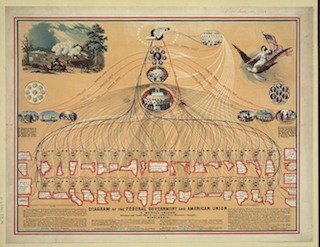
Resource O.
http://memory.loc.gov/cgi-bin/map_item.pl
(zoom in using electronic version)

Questions? Contact Project Director Audrey Shafer-Erickson
This site sponsored by Minnesota State University Moorhead
Ohio State nav bar
Ohio state navigation bar.
- BuckeyeLink
- Search Ohio State
United States History
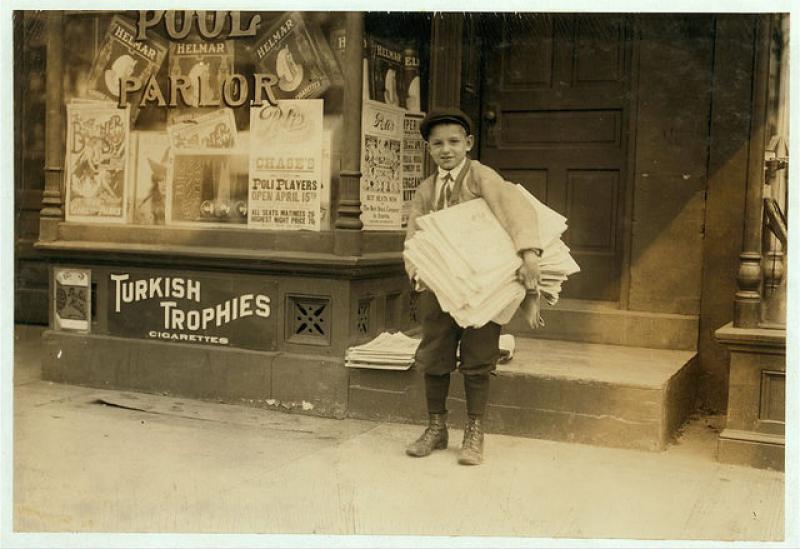
(A ten-year-old newsie carrying a heavy load of newspapers in Washington, D.C. April 1912.)
Lesson Plans
1920s Consumer Culture
Espionage in the American Revolution
Indian Removal
The Loyalists
Manifest Destiny and Westward Expansion
Native American History: John Smith and the Powhatan
- Lynchings
Women's Suffrage, 1890 - 1920 World War II: The Homefront
- Lesson Plans
- Teacher's Guides
- Media Resources
Advanced Placement U.S. History Lessons

The Capture of the Hessians at Trenton December 26, 1776 by John Trumbull.
Wikimedia Commons
EDSITEment brings online humanities resources directly to the classroom through exemplary lesson plans and student activities. EDSITEment develops AP level lessons based on primary source documents that cover the most frequently taught topics and themes in American history. Many of these lessons were developed by teachers and scholars associated with the City University of New York and Ashland University.
Guiding Questions
What does it mean to form "a more perfect union"?
What makes American democracy unique?
What is the proper role of government in relation to the economy and civil liberties?
To what extent is the U.S. Constitution a living document?
To what extent have civil rights been established for all in the United States?
How have technology and innovation influenced culture, politics, and economics in U.S. history?
What role should the United States government and its citizens play in the world?
Magna Carta: Cornerstone of the U.S. Constitution —Magna Carta served to lay the foundation for the evolution of parliamentary government and subsequent declarations of rights in Great Britain and the United States. In attempting to establish checks on the king's powers, this document asserted the right of "due process" of law.
Images of the New World —How did the English picture the native peoples of America during the early phases of colonization of North America? This lesson plan enables students to interact with written and visual accounts of this critical formative period at the end of the 16th century, when the English view of the New World was being formulated, with consequences that we are still seeing today.
Mission Nuestra Señora de la Concepción and the Spanish Mission in the New World —In this Picturing America lesson, students explore the historical origins and organization of Spanish missions in the New World and discover the varied purposes these communities of faith served. Focusing on the daily life of Mission Nuestra Señora de la Concepción, the lesson asks students to relate the people of this community and their daily activities to the art and architecture of the mission.
Colonizing the Bay —This lesson focuses on John Winthrop’s historic "Model of Christian Charity" sermon which is often referred to by its "City on a Hill" metaphor. Through a close reading of this admittedly difficult text, students will learn how it illuminates the beliefs, goals, and programs of the Puritans. The sermon sought to inspire and to motivate the Puritans by pointing out the distance they had to travel between an ideal community and their real-world situation.
Mapping Colonial New England: Looking at the Landscape of New England —The lesson focuses on two 17th century maps of the Massachusetts Bay Colony to trace how the Puritans took possession of the region, built towns, and established families on the land. Students learn how these New England settlers interacted with the Native Americans, and how to gain information about those relationships from primary sources such as maps.
William Penn’s Peaceable Kingdom —By juxtaposing the different promotional tracts of William Penn and David Pastorius, students understand the ethnic diversity of Pennsylvania along with the "pull” factors of migration in the 17th century English colonies.
Understanding the Salem Witch Trials —In 1691, a group of girls from Salem, Massachusetts accused an Indian slave named Tituba of witchcraft, igniting a hunt for witches that left 19 men and women hanged, one man pressed to death, and over 150 more people in prison awaiting a trial. In this lesson, students explore the characteristics of the Puritan community in Salem, learn about the Salem Witchcraft Trials, and try to understand how and why this event occurred.
Religion in 18th-Century America —This curriculum unit, through the use of primary documents, introduces students to the First Great Awakening, as well as to the ways in which religious-based arguments were used both in support of and against the American Revolution.
- Lesson 1: The First Great Awakening
- Lesson 2: Religion and the Argument for American Independence
- Lesson 3: Religion and the Fight for American Independence
C ommon Sense : The Rhetoric of Popular Democracy —This lesson looks at Tom Paine and at some of the ideas presented in Common Sense , such as national unity, natural rights, the illegitimacy of the monarchy and of hereditary aristocracy, and the necessity for independence and the revolutionary struggle.
"An Expression of the American Mind”: Understanding the Declaration of Independence —This lesson plan looks at the major ideas in the Declaration of Independence, their origins, the Americans’ key grievances against the King and Parliament, their assertion of sovereignty, and the Declaration’s process of revision. Upon completion of the lesson, students will be familiar with the document’s origins, and the influences that produced Jefferson’s "expression of the American mind.”
The American War for Independence —The decision of Britain's North American colonies to rebel against the Mother Country was an extremely risky one. In this unit, consisting of three lesson plans, students learn about the diplomatic and military aspects of the American War for Independence.
- Lesson 1: The War in the North, 1775–1778
- Lesson 2: The War in the South, 1778–1781
- Lesson 3: Ending the War, 1783
Choosing Sides: The Native Americans' Role in the American Revolution —Native American groups had to choose the loyalist or patriot cause—or somehow maintain a neutral stance during the Revolutionary War. Students analyze maps, treaties, congressional records, first-hand accounts, and correspondence to determine the different roles assumed by Native Americans in the American Revolution and understand why the various groups formed the alliances they did.
What Made George Washington a Good Military Leader? —What combination of experience, strategy, and personal characteristics enabled Washington to succeed as a military leader? In this unit, students read the Continental Congress's resolutions granting powers to General Washington, and analyze some of Washington's wartime orders, dispatches, and correspondence in terms of his mission and the characteristics of a good general.
- Lesson 1: What Made George Washington a Good Military Leader? What Are the Qualities of a Good Military Leader?
- Lesson 2: What Made George Washington a Good Military Leader? Powers and Problems
- Lesson 3: What Made George Washington a Good Military Leader? Leadership in Victory and Defeat
- Lesson 4: What Made George Washington a Good Military Leader? Leadership in Victory: One Last Measure of the Man
Slavery and the American Founding: The "Inconsistency not to be excused ” —This lesson focuses on the views of the founders as expressed in primary documents from their own time and in their own words. Students see that many of the major founders opposed slavery as contrary to the principles of the American Revolution. Students gain a better understanding of the views of many founders, even those who owned slaves – including George Washington and Thomas Jefferson – who looked forward to a time when slavery would no longer mar the American Republic.
Taking Up Arms and the Challenge of Slavery in the Revolutionary Era —Was the American Revolution inevitable? This lesson is designed to help students understand the transition to armed resistance and the contradiction in the Americans’ rhetoric about slavery through the examination of a series of documents.
Slavery in the Colonial North —This Closer Reading composed by Historic Hudson Valley in New York provides resources and an overview of how their historic site tells the story of the 23 enslaved Africans who were the only full-time, year round residents of the Manor, and whose forced labor was the backbone of the Philips’s international trading empire. Their "People Not Property" interactive documentary website offers multimedia resources and access to primary sources about Northern slavery.
Democracy in America : Alexis de Tocqueville's Introduction —Tocqueville’s sojourn in America led to the writing of the reflection on equality and freedom known as Democracy in America . This great book remains arguably one of the two most important books on America political life, the Federalist Papers being the other one.
The Constitutional Convention of 1787 —The delegates at the 1787 Convention faced a challenge as arduous as those who worked throughout the 1780s to initiate reforms to the American political system. In this unit, students examine the roles that key American founders played in creating the Constitution, and the challenges they faced in the process.
- Lesson 1: The Road to the Constitutional Convention
- Lesson 2: The Question of Representation at the 1787 Convention
- Lesson 3: Creating the Office of the Presidency
The Federalist and Anti-federalist Debates on Diversity and the Extended Republic —In this unit, students will examine some of the most important arguments of those opposing or supporting the Constitution. They will learn why Anti-federalists believed that a large nation could not long preserve liberty and self-government and why Federalists such as James Madison believed that a large nation was vital to promote justice and the security of rights for all citizens, majority and minority alike.
- Lesson 1: Anti-federalist Arguments Against "A Complete Consolidation ”
- Lesson 2: The Federalist Defense of Diversity and "Extending the Sphere ”
Ratifying the Constitution —This lesson introduces students to the vigorous debates surrounding the ratification of the Constitution that took place in the state conventions.
The Creation of the Bill of Rights: "Retouching the Canvas " —This lesson will focus on the arguments either for or against the addition of a Bill of Rights between 1787 and 1789.
Washington and the Whiskey Rebellion —Students weigh the choices Washington faced in the nation’s first Constitutional crisis by following events through his private diary.
John Marshall, Marbury v. Madison and Judicial Review—How the Court Became Supreme —If James Madison was the "father" of the Constitution" John Marshall was the "father of the Supreme Court"—almost single-handedly clarifying its powers. This new lesson is designed to help students understand Marshall's brilliant strategy in issuing his decision on Marbury v. Madison , the significance of the concept of judicial review, and the language of this watershed case.
The First American Party System: Events, Issues, and Positions —Fear of factionalism and political parties was deeply rooted in Anglo-American political culture before the American Revolution. Leaders such as George Washington and Thomas Jefferson hoped their new government, founded on the Constitution, would be motivated instead by a common intent, a unity. But political parties did form in the United States, with their beginnings in Washington's cabinet.
- Lesson 1: The First American Party System: U.S. Political Parties: The Principle of Legitimate Opposition
- Lesson 2: The First American Party System: A Documentary Timeline of Important Events (1787–1800)
- Lesson 3: The First American Party System: Federalists and Democratic-Republicans: The Platforms They Never Had
Certain Crimes Against the United States: The Sedition Act —As the end of the 18th century drew near, relations between the United States and France were deteriorating. In 1797 President Adams expressed his concern about the possibility of war with France and dissension at home caused by France and its supporters. At the same time, two opposing political parties were developing in the U.S., with Thomas Jefferson-led Democratic-Republicans tending to sympathize with France in foreign policy. Their loyalty was called into question by the Federalists. It was a dangerous time both for the security of the young Republic and the freedoms its citizens enjoyed.
- Lesson 1: From the President's Lips: The Concerns that Led to the Sedition (and Alien) Act
- Lesson 2: The Debate in Congress on the Sedition Act
- Lesson 3: George Washington on the Sedition Act
- Lesson 4: Thomas Jefferson on the Sedition Act
- Lesson 5: Consequences of the Sedition Act
James Madison: From Father of the Constitution to President —Even in its first 30 years of existence, the U.S. Constitution had to prove its durability and flexibility in a variety of disputes. More often than not, James Madison, the "Father of the Constitution," took part in the discussion.
- Lesson 1: James Madison: Madison Was There
- Lesson 2: James Madison: The Second National Bank—Powers Not Specified in the Constitution
- Lesson 3: James Madison: Raising an Army: Balancing the Power of the States and the Federal Government
- Lesson 4: James Madison: Internal Improvements Balancing Act: Federal/State, Executive/Legislative
The Monroe Doctrine: Origin and Early American Foreign Policy —Monroe brought a vision of an expanded America to his presidency—a vision that helped facilitate the formulation of what has become known as the Monroe Doctrine. In this unit, students review the Monroe Doctrine against a background of United States foreign relations in the early years of the republic.
- Lesson 1: The Monroe Doctrine: U.S. Foreign Affairs (circa 1782–1823) and James Monroe
- Lesson 2: The Monroe Doctrine: President Monroe and the Independence Movement in South America
- Lesson 3: The Monroe Doctrine: A Close Reading
- Lesson 4: The Monroe Doctrine: Whose Doctrine Was It?
The Election Is in the House: The Presidential Election of 1824 —The presidential election of 1824 represents a watershed in American politics. The collapse of the Federalist Party and the illness of the "official candidate" of the Democratic-Republicans led to a slate of candidates who were all Democratic-Republicans. This led to the end of the Congressional Caucus system for nominating candidates, and eventually, the development of a new two-party system in the United States. In this unit, students read an account of the election from the Journal of the House of Representatives, analyze archival campaign materials, and use an interactive online activity to develop a better understanding of the election of 1824 and its significance.
- Lesson 1: The Election Is in the House: The Denouement
- Lesson 2: The Election Is in the House: 1824: The Candidates and the Issues
- Lesson 3: The Election Is in the House: Was There a Corrupt Bargain?
The 1828 Campaign of Andrew Jackson and the Growth of Party Politics —Changes in voting qualifications and participation, the election of Andrew Jackson, and the formation of the Democratic Party—due largely to the organizational skills of Martin Van Buren—all contributed to making the election of 1828 and Jackson’s presidency a watershed in the evolution of the American political system. In this unit, students analyze changes in voter participation and regional power, and review archival campaign documents reflecting the dawn of politics as we know it during the critical years from 1824 to 1832.
- Lesson 1: The 1828 Campaign of Andrew Jackson: Expansion of the Voting Base
- Lesson 2: The 1828 Campaign of Andrew Jackson: Changes in Voting Participation
- Lesson 3: The 1828 Campaign of Andrew Jackson: Territorial Expansion and the Shift of Power
- Lesson 4: The 1828 Campaign of Andrew Jackson: Issues in the Election of 1828 (and Beyond)
The Campaign of 1840: William Henry Harrison and Tyler, Too —After the debacle of the one-party presidential campaign of 1824, a new two-party system began to emerge. Strong public reaction to perceived corruption in the vote in the House of Representatives, as well as the popularity of Andrew Jackson, allowed Martin Van Buren to organize a Democratic Party that resurrected a Jeffersonian philosophy of minimalism in the federal government. What issues were important to the presidential campaign of 1840? Why is the campaign of 1840 often cited as the first modern campaign?
- Lesson 1: The Campaign of 1840: The Whigs, the Democrats, and the Issues
- Lesson 2: The Campaign of 1840: The Candidates
- Lesson 3: The Campaign of 1840: The Campaign
Was There an Industrial Revolution? Americans at Work Before the Civil War —In this lesson, students explore the First Industrial Revolution in early nineteenth-century America. By reading and comparing first-hand accounts of the lives of workers before the Civil War, students prepare for a series of guided role-playing activities designed to help them make an informed judgment as to whether the changes that took place in manufacturing and distribution during this period are best described as a 'revolution' or as a steady evolution over time.
Was There an Industrial Revolution? New Workplace, New Technology, New Consumers —In this lesson, students explore the First Industrial Revolution in early nineteenth-century America. Through simulation activities and the examination of primary historical materials, students learn how changes in the workplace and less expensive goods led to the transformation of American life.
Life in the North and South 1847–1861: Before Brother Fought Brother —Curriculum Unit overview. More Americans lost their lives in the Civil War than in any other conflict. How did the United States arrive at a point at which the South seceded and some families were so fractured that brother fought brother?
- Lesson 1: Factory vs. Plantation in the North and South
- Lesson 2: People and Places in the North and South
- Lesson 3: A Debate Against Slavery
- Lesson 4: Life Before the Civil War
- Lesson 5: Women's Lives Before the Civil War
A House Dividing: The Growing Crisis of Sectionalism in Antebellum America —In this unit, students will trace the development of sectionalism in the United States as it was driven by the growing dependence upon, and defense of, black slavery in the southern states.
- Lesson 1: An Early Threat of Secession: The Missouri Compromise of 1820 and the Nullification Crisis
- Lesson 2: Slavery's Opponents and Defenders
- Lesson 3: The Kansas-Nebraska Act of 1854: Popular Sovereignty and the Political Polarization over Slavery
- Lesson 4: Abraham Lincoln, the 1860 Election, and the Future of the American Union and Slavery
From Courage to Freedom —In 1845 Frederick Douglass published what was to be the first of his three autobiographies: the Narrative of the Life of Frederick Douglass, an American Slave, Written by Himself .
- Lesson 1: From Courage to Freedom: The Reality behind the Song
- Lesson 2: From Courage to Freedom: Slavery's Dehumanizing Effects
- Lesson 3: From Courage to Freedom
What to the Slave is the Fourth of July? —A student activity. Frederick Douglass (1818–1895) was a former slave who became the greatest abolitionist orator of the antebellum period. During the Civil War he worked tirelessly for the emancipation of the four million enslaved African Americans.
The American Civil War: A "Terrible Swift Sword ” —This curriculum unit introduces students to important questions pertaining to the war: strengths and weaknesses of each side at the start of the conflict; the two turning points of the war-the concurrent battles of Gettysburg and Vicksburg—as well as the morality of the Union's use of "total war" tactics against the population of the South; Abraham Lincoln's wartime leadership.
- Lesson 1: On the Eve of War: North vs. South
- Lesson 2: The Battles of the Civil War
- Lesson 3: Abraham Lincoln and Wartime Politics
Abraham Lincoln on the American Union: "A Word Fitly Spoken ” —By examining Lincoln's three most famous speeches—the Gettysburg Address and the First and Second Inaugural Addresses—in addition to a little known fragment on the Constitution, union, and liberty, students trace what these documents say regarding the significance of union to the prospects for American self-government.
- Lesson 1: Fragment on the Constitution and Union (1861)—The Purpose of the American Union
- Lesson 2: The First Inaugural Address (1861)—Defending the American Union
- Lesson 3: The Gettysburg Address (1863)—Defining the American Union
- Lesson 4: The Second Inaugural Address (1865)—Restoring the American Union
The Emancipation Proclamation: Freedom's First Steps —Why was the Emancipation Proclamation important? While the Civil War began as a war to restore the Union, not to end slavery, by 1862 President Abraham Lincoln came to believe that he could save the Union only by broadening the goals of the war. students can explore the obstacles and alternatives we faced in making the journey toward "a more perfect Union."
The Red Badge of Courage : A New Kind of Courage —In The Red Badge of Courage , Stephen Crane presents war through the eyes —and thoughts —of one soldier. The narrative’s altered point of view and stylistic innovations enable a heightened sense of realism while setting the work apart from war stories written essentially as tributes or propaganda.
The Battle Over Reconstruction —This curriculum unit of three lessons examines the social, political and economic conditions of the southern states in the aftermath of the Civil War and shows how these factors helped to shape the Reconstruction debate as well as the subsequent history of American race relations.
- Lesson 1: The Battle Over Reconstruction: The Aftermath of War
- Lesson 2: The Battle Over Reconstruction: The Politics of Reconstruction
- Lesson 3: The Battle Over Reconstruction: The Aftermath of Reconstruction
The Industrial Age in America: Robber Barons or Captains of Industry?
The Industrial Age in America: Sweatshops, Steel Mills and Factories
The Birth of an American Empire —America emerges as a world power after the Spanish American War and asserting itself on the world scene.
- Lesson 1: The Question of an American Empire
- Lesson 2: The Spanish-American War
- Lesson 3: The Matter of the Philippines
- Lesson 4: Imperialism and the Open Door
United States Entry into World War I: A Documentary Chronology —In this curriculum unit, students reconsider the events leading to U.S. entry into World War I through the lens of archival documents.
- Lesson 1: United States Entry into World War I: Two Diametrically Opposed Views
- Lesson 2: United States Entry into World War I: Some Hypotheses About U.S. Entry
- Lesson 3: United States Entry into World War I: A Documentary Chronology of World War I
The United States and Europe: From Neutrality to War, 1921–1941 —Over the two decades between World War I and World War II, Americans pursued strategies aimed at preventing another war. In this four lesson unit, students use primary sources and an interactive map to examine the rise of antiwar sentiment and legislation in the United States and the main arguments used by both sides as to whether the United States should enter the war or remain neutral.
- Lesson 1: Postwar Disillusionment and the Quest for Peace, 1921–1929
- Lesson 2: Legislating Neutrality, 1934–1939
- Lesson 3: U.S. Neutrality and the War in Europe, 1939–1940
- Lesson 4: The Great Debate: Internationalists vs. Isolationists
African-American Soldiers in World War I: The 92nd and 93rd Divisions —Late in 1917, the War Department created two all-black infantry divisions. The 93rd Infantry Division received unanimous praise for its performance in combat, fighting as part of France’s 4th Army. In this lesson, students combine their research in a variety of sources, including firsthand accounts, to develop a hypothesis evaluating.
African-American Soldiers After World War I: Had Race Relations Changed? —In this lesson, students view archival photographs, combine their efforts to comb through a database of more than 2,000 archival newspaper accounts about race relations in the United States, and read newspaper articles written from different points of view about post-war riots in Chicago.
The Great War: Evaluating the Treaty of Versailles —Was the Treaty of Versailles, which formally concluded World War I, a legitimate attempt by the victorious powers to prevent further conflict, or did it place an unfair burden on Germany? This lesson helps students respond to the question in an informed manner. Activities involve primary sources, maps, and other supporting documents related to the peace process and its reception by the German public and German politicians.
The Debate in the United States over the League of Nations —American foreign policy continues to resonate with the issues surrounding the debate over U.S. entry into the League of Nations—collective security versus national sovereignty, idealism versus pragmatism, the responsibilities of powerful nations, and the use of force to accomplish idealistic goals, the idea of America. Understanding the debate over the League and the consequences of its ultimate failure provides insight into international affairs in the years since the end of the Great War and beyond. In this lesson, students read the words and listen to the voices of some central participants in the debate over the League of Nations.
- Lesson 1: The Debate in the United States over the League of Nations: League of Nations Basics
- Lesson 2: The Debate in the United States over the League of Nations: Disagreement Over the League
- Lesson 3: The Debate in the United States over the League of Nations: Five Camps: From Voices of Consent to Voices of Dissent
Woodrow Wilson and Foreign Policy —Curriculum Unit. The influence of President Woodrow Wilson on American foreign policy has been profound and lasting. Using a variety of primary sources, students analyze the origins of the ambitious foreign policy that came to be known as Wilsonianism and compare it with important alternative traditions in American foreign policy.
The Origins of "Wilsonianism ”
"To Elect Good Men”: Woodrow Wilson and Latin America
Wilson and American Entry into World War I
Fighting for Peace: The Fate of Wilson's Fourteen Points
Birth of a Nation, the NAACP, and the Balancing of Rights —In this lesson students learn how Birth of a Nation reflected and influenced racial attitudes, and they analyze and evaluate the efforts of the NAACP to prohibit showing of the film.
NAACP's Anti-Lynching Campaigns: The Quest for Social Justice in the Interwar Years —Curriculum Unit Overview: During the years 1909 to 1939, the National Association for the Advancement of Colored People sought passage of anti-lynching legislation. Although this proposed legislation failed to become law, much can be learned by examining the NAACP's anti-lynching campaign about how Americans in the interwar period understood the federal system, interpreted the Constitution, and responded to calls for social justice.
- Lesson 1: NAACP’s Anti-Lynching Campaign in the 1920s
FDR's Fireside Chats: The Power of Words —In this lesson which focuses on two of FDR's Fireside Chats, students gain a sense of the dramatic effect of FDR's voice on his audience, see the scope of what he was proposing in these initial speeches, and make an overall analysis of why the Fireside Chats were so successful.
The Social Security Act —This lesson engages students in the debate over the Social Security Act that engrossed the nation during the 1930s.
African-Americans and the New Deal’s Civilian Conservation Corps —The Civilian Conservation Corps, a New Deal recovery and relief program provided more than a quarter of a million young black men with jobs during the Depression. By examining primary source documents students analyze the impact of this program on race relations in America and assess the role played by the New Deal in changing them.
FDR and the Lend-Lease Act —This lesson shows students how broadly the Lend-Lease Act of March 1941 empowered the federal government—particularly the President—and asks students to investigate how FDR promoted the program in speeches and then in photographs.
Eleanor Roosevelt and the Rise of Social Reform in the 1930s —This lesson asks students to explore the various roles that Eleanor Roosevelt a key figure in several of the most important social reform movements of the twentieth century took on, among them: First Lady, political activist for civil rights, newspaper columnist and author, and representative to the United Nations.
Worth a Thousand Words: Depression-Era Photographs —Spend a day with a model American family and the photographer who molded our view of their lives.
Freedom by the Fireside: The Legacy of FDR's "Four Freedoms" Speech —One of the most famous political speeches on freedom in the twentieth century was delivered by Franklin Delano Roosevelt in his 1941 State of the Union message to Congress.This lesson examines some of the nuances and ambiguities inherent in the rhetorical use of "freedom." The objective is to encourage students to glimpse the broad range of hopes and aspirations that are expressed in the call of—and for—freedom.
Dust Bowl Days —Students will be introduced to this dramatic era in our nation's history through photographs, songs and interviews with people who lived through the Dust Bowl.
NAACP Lesson 2: NAACP's Anti-Lynching Campaign in the 1930s
From Neutrality to War: The United States and Europe, 1921–1941 —Curiculum unit overview. Over the two decades between World War I and World War II, Americans pursued strategies aimed at preventing another war. In this four lesson unit, students use primary sources and an interactive map to examine the rise of antiwar sentiment and legislation in the United States and the main arguments used by both sides as to whether the United States should enter the war or remain neutral.
The Road to Pearl Harbor: The United States and East Asia, 1915-1941 —Curiculum unit overview. Although most Americans were shocked by the Japanese attack on Pearl Harbor on December 7, 1941, the outbreak of war between the two countries came as no surprise to most observers of international affairs. Using contemporary documents, students explore the rise of animosity between the United States and Japan from its origins in World War I and culminating two decades later in the Pearl Harbor attack.
- Lesson 1: The Growth of U.S.-Japanese Hostility, 1915–1932
- Lesson 2: America and the Sino-Japanese Conflict, 1933–1939
- Lesson 3: Japan's "Southern Advance” and the March toward War, 1940–1941
- Lesson 4: The Failure of Diplomacy, September-December 1941
"The Proper Application of Overwhelming Force”: The United States in World War II —After learning that the Japanese had attacked Pearl Harbor, thus ensuring that the United States would enter World War II, Prime Minister Winston Churchill breathed a sigh of relief. "Hitler's fate was sealed," he would later recall. "Mussolini's fate was sealed. As for the Japanese, they would be ground to powder. All the rest was merely the proper application of overwhelming force." In this unit, students examine the role that the United States played in bringing about this victory.
- Lesson 1: Turning the Tide in the Pacific, 1941–1943
- Lesson 2: Turning the Tide in Europe, 1942–1944
- Lesson 3: Victory in Europe, 1944–1945
- Lesson 4: Victory in the Pacific, 1943–1945
American Diplomacy in World War II —This four-lesson curriculum unit examine the nature of what Winston Churchill called the "Grand Alliance" between the United States, Great Britain, and the Soviet Union in opposition to the aggression of Nazi Germany and Imperial Japan.
- Lesson 1: How "Grand” and "Allied” was the Grand Alliance?
- Lesson 2: How to Win a World War
- Lesson 3: Victory and the New Order in Europe
- Lesson 4: The New Order for "Greater East Asia”
On the Home Front —Learning about World War II American efforts helps students gain some perspective regarding the U.S. response to the conflict generated by the September 11th terrorist attacks.
Norman Rockwell, Freedom of Speech —Know It When You See It —This lesson plan highlights the importance of First Amendment rights by examining Norman Rockwell’s painting of The Four Freedoms. Students discover the First Amendment in action as they explore their own community and country through newspapers, art, and role playing.
The Origins of the Cold War, 1945–1949 —Since the Bolshevik Revolution of 1917, Soviet leaders had been claiming that communism and capitalism could never peacefully coexist. Agreements regarding the postwar world were reached at Yalta and Potsdam, but the Soviets wasted no time in violating them. Harry Truman believed that the proper means of responding to an international bully was a credible threat of force.
- Lesson 1: Sources of Discord, 1945–1946
- Lesson 2: The Strategy of Containment, 1947–1948
- Lesson 3: The Formation of the Western Alliance, 1948–1949
Witch Hunt or Red Menace? Anticommunism in Postwar America, 1945–1954 —Americans emerged from World War II as the only major combatant to avoid having its homeland ravaged by war, the U.S. economy was clearly the strongest in the world, and, of course, the United States was the only country in the world to possess that awesome new weapon, the atomic bomb. However, over the next five years relations between the United States and the Soviet Union went from alliance to Cold War.
- Lesson 1: Soviet Espionage in America
- Lesson 2: The House Un-American Activities Committee
- Lesson 3: The Rise and Fall of Joseph McCarthy
Dramatizing History in Arthur Miller's The Crucible —By closely reading historical documents and attempting to interpret them, students consider how Arthur Miller interpreted the facts of the Salem witch trials and how he successfully dramatized them in his play, The Crucible. As they explore historical materials, such as the biographies of key players (the accused and the accusers) and transcripts of the Salem Witch trials themselves, students will be guided by aesthetic and dramatic concerns: In what ways do historical events lend themselves (or not) to dramatization? What makes a particular dramatization of history effective and memorable?
"Police Action”: The Korean War, 1950–1953 —In 1950, North Korean forces, armed mainly with Soviet weapons, invaded South Korea in an effort to reunite the peninsula under communist rule. This lesson will introduce students to the conflict by having them read the most important administration documents related to it.
"The Missiles of October”: The Cuban Missile Crisis, 1962 —Most historians agree that the world has never come closer to nuclear war than it did during a thirteen-day period in October 1962, after the revelation that the Soviet Union had stationed several medium-range ballistic missiles in Cuba. This lesson examines how this crisis developed, how the Kennedy administration chose to respond, and how the situation was ultimately resolved.
The Gulf of Tonkin Resolution and Escalation of the Vietnam War —In August 1964, a small military engagement off the coast of North Vietnam helped escalate the involvement of the United States in Vietnam; the Vietnam War would become the longest military engagement in American history.
Building Suburbia: Highways and Housing in Postwar America —The postwar United States experienced a dramatic economic boom—and a dramatic reorientation of American ideals of the home.
Competing Voices of the Civil Rights Movement —When most people think of the Civil Rights Movement in America, they think of Martin Luther King, Jr. Delivering his "I Have a Dream" speech on the steps of the Lincoln Memorial in 1963. But "the Movement" achieved its greatest results due to the competing strategies and agendas of diverse individuals. This unit presents the views of several important black leaders who shaped the debate over how to achieve freedom and equality in our nation.
- Lesson 1: Martin Luther King, Jr. and Nonviolent Resistance
- Lesson 2: Black Separatism or the Beloved Community? Malcolm X and Martin Luther King, Jr.
Profiles in Courage: To Kill A Mockingbird and the Scottsboro Boys Trial —Students study select court transcripts and other primary source material from the second Scottsboro Boys Trial of 1933, a continuation of the first trial in which two young white women wrongfully accused nine African-American youths of rape.
JFK, LBJ, and the Fight for Equal Opportunity in the 1960s —This lesson provides students with an opportunity to study and analyze the innovative legislative efforts of Presidents Kennedy and Johnson in the social and economic context of the 1960s.
The Kennedy Administration and the Civil Rights Movement —Students learn how civil rights activists, state and local officials in the South, and the Administration of President Kennedy come into conflict during the early 1960s.
Freedom Riders and the Popular Music of the Civil Rights Era —The American civil rights movement incorporated a variety of cultural elements in their pursuit of political and legal equality under law. This lesson will highlight the role of music as a major influence through the use of audio recordings, photographs, and primary documents.
Twelve Angry Men: Trial by Jury as a Right and as a Political Institution — Twelve Angry Men , originally written for television by Reginald Rose in 1954 and subsequently adapted for stage (1955), film (1957) and television again (1997), effectively conveys the central importance of the right to a jury trial afforded by Article III of the Constitution as well as Amendments V, VI, and XIV.
Building Suburbia: Highways and Housing in Postwar America
The Election of Barack Obama 44th President of the United States —In this lesson, students put Barack Obama’s election as the first African-American President of the United States in historical context by studying two of his speeches and reviewing some of the history of African-American voting rights.

IMAGES
VIDEO
COMMENTS
This is an inquiry lesson where students will do research to answer the inquiry question concerning the reconstruction period following the civil war. Students will develop a hypothesis, search for evidence in multiple primary and secondary sources, and complete a graphic organizer. Through this process students will develop a strong answer to ...
The Aftermath of War: Worksheet 1. The Aftermath of War: Worksheet 2. This lesson covers two essential aspects of Reconstruction: the condition of the southern states at the close of the war and Lincoln's plan for restoring them to the Union. In examining the conditions of the southern states, students consider both the physical conditions (i ...
Lesson Plan. The Civil War and Reconstruction Era brought about the end of slavery and the expansion of civil rights to African Americans through the 13th, 14th, and 15th Amendments. Compare the Northern and Southern states, discover the concepts of due process and equal protection, and understand how the former Confederate states reacted to ...
This 13-lesson unit, adapted from our Reconstruction Era book and part of a larger collection on the history of the Reconstruction era, is designed to fit within approximately three weeks. In this unit, students investigate the challenges of creating a just democracy in a time of deep division. The resources included here have been selected and ...
7. Reconstruction | Download Lesson Plans and Student Activity Sheets for the Reconstruction unit from Teaching with Documents: Colonial America to Reconstruction below, and scroll down to explore the interactive map: Lesson Plans Student Activity Sheets Click on the interactive map below to explore: | Download Lesson Plans and Student Activity Sheets for the Reconstruction unit from Teaching ...
imbedded in the origins of the United States. . . . When the Civil War ended, the political Reconstruction of the South progressed in two distinct eras. The first was Presidential Reconstruction, from 1865 through early spring 1867, when Andrew Johnson shaped the pace and depth of the reintegration of the South into the United States following
During the Reconstruction Era, Americans were faced with the challenge of rebuilding a society divided by slavery and the political upheaval of the Civil War. Teaching this history is essential to helping students understand citizenship and democracy in the United States today. The collection includes multiple entry-points for exploring the ...
The American Civil War was fought from 1861-1865, and followed by the period of Reconstruction, generally accepted by scholars to have ended in 1877. The following collections include documents essential to gaining and understanding of how the war began, progressed, and ended, and how Reconstruction was conceived and attempted.
1:1 lesson. Lesson overview: Freedpeople built and expanded existing institutions during Reconstruction, many of which had their roots in practices begun by enslaved people. They included religion, education, benevolent organizations, the press, and the family. Today's lesson titled, "Teaching Ourselves," focuses on education.
This lesson will allow students to explore Lincoln's words, speeches, and proclamations in order to understand his views on secession, amnesty, and Reconstruction, as well as his hopes for the nation. Objectives Students will examine primary documents in order to understand and evaluate Lincoln's plans for Reconstruction.
Manage Classes & Assignments. Sync with Google Classroom. Create Lessons. Customized Dashboard. Find lessons on Reconstruction for all grades. Free interactive resources and activities for the classroom and home.
The effects of the Civil War and of Reconstruction—particularly in the South—continue to shape and to be a contentious subject in our politics today. This lesson plan will explore the social, economic and political conditions of the United States as Reconstruction drew to a close in the years leading up to the Compromise of 1877.
This lesson is part of Facing History's work on the Reconstruction era and part of a series of lessons focused on our Reconstruction videos. Use this lesson at the end of a unit about Reconstruction to engage students in a conversation about America's ongoing struggle for a stronger democracy. In addition to the suggestions below, see ...
This Lesson Plan was revised 01/19/2006 Slave Narratives: Constructing U.S. History Through Analyzing Primary Sources —The realities of slavery and Reconstruction hit home in poignant oral histories from the Library of Congress.
Our campaign aims to help teachers and schools uncover the hidden, bottom-up history of this era. We offer lessons for middle and high school, a national report, a student campaign to make Reconstruction history visible in their communities, and an annotated list of recommended teaching guides, student friendly books, primary document ...
U.S. History: Reconstruction to Modern America. Reconstruction & New South; Westward Expansion; Industrial America; ... High School African American History, English/Language Arts ... This is an adaptation for 5th Grade of the high school lesson plan, "Education Reform During the Progressive Era and the Rosenwald Schools of the American South" ...
Teaching American History on the Great Plains. Summer 2010 - Lesson Plan 2 . Class: CIHS America History 1301 Reconstruction Objective: For students to expand their understanding of the politics, struggles, and shortfalls of putting the United States back together after the American Civil War.
Lincoln's Proclamation of Amnesty and Reconstruction of December 8, 1863, set forth a plan, known widely as the "Ten-Percent Plan," that required only "a number of persons, not less than one tenth in number of the votes cast in such state at the presidential election" of 1860, to take an oath of loyalty to the United States and then vote to re-establish legitimate republican government.
See also Joe Biden. Return to Main Index. Hundreds of U.S. history lesson plans and resources for K-12 teachers including age of exploration, colonial period, revolutionary war, age of expansion, 1800s, slavery, civil war, 1900s, great depression, world war II, cold war, 1960s Vietnam War, 1970s, 1980s,1990s , and 2000s.
In which John Green teaches you about Reconstruction. After the divisive, destructive Civil War, Abraham Lincoln had a plan to reconcile the country and make...
History Lesson Plans. American History - Connecting to the Past. Adena & Hopewell Cultures: Artifact Analysis; African Slave Trade. ... Reconstruction. Lead Us Not into Temptation; Reconstruction (Image) Republican Principles vs. Democratic Principles; This is a White Man's Government;
EDSITEment brings online humanities resources directly to the classroom through exemplary lesson plans and student activities. EDSITEment develops AP level lessons based on primary source documents that cover the most frequently taught topics and themes in American history. Many of these lessons were developed by teachers and scholars associated with the City University of New York and Ashland ...